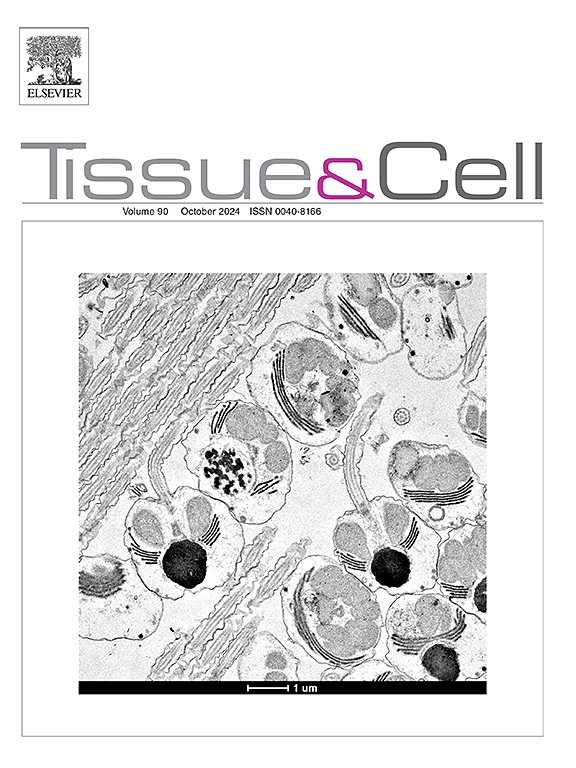Knockdown of dual-specificity phosphatase 3 drives differentiation and polarization of myeloid leukemia cells into macrophages with reduced proliferative and DNA repair fitness
IF 2.7
4区 生物学
Q1 ANATOMY & MORPHOLOGY
引用次数: 0
Abstract
Dual-specificity phosphatase 3 (DUSP3) regulates key cellular processes, including the cell cycle, proliferation, and differentiation. Recently, we demonstrated its crucial role in maintaining genomic stability by interacting with and dephosphorylating nucleophosmin (NPM), thereby modulating nuclear p53 activity under genotoxic stress. Given the frequent mutations in both p53 and NPM in acute myeloid leukemia (AML), this study aimed to investigate the impact of DUSP3 knockdown in two p53-deficient AML cell lines and explore potential correlations with NPM expression. THP-1 cells exhibited higher basal levels of DUSP3 and NPM compared to HL-60 cells, while DUSP3 knockdown reduced NPM expression in HL-60 cells. Upon phorbol 12-myristate 13-acetate (PMA)-induced differentiation into macrophage-like cells, only HL-60 cells displayed decreased levels of both DUSP3 and NPM. DUSP3 knockdown enhanced differentiation in THP-1 and HL-60 cells and promoted non-classical M2 macrophage polarization following additional PMA exposure, as indicated by increased expression of CD11b and CD206. Bioinformatics analysis revealed significant correlations between DUSP3 and NPM gene expression, AML patient survival, and the maturation stage of myeloid cells. Furthermore, DUSP3 knockdown in undifferentiated HL-60 cells impaired proliferation and compromised genomic stability under genotoxic stress induced by doxorubicin. These findings suggest that DUSP3 plays a regulatory role in the differentiation, polarization, and proliferation of myeloid cells. Through the modulation of NPM expression and activity, DUSP3 may contribute to a deeper understanding of leukemia pathophysiology and mechanisms of chemotherapy resistance.
双特异性磷酸酶3的敲低驱动髓系白血病细胞分化和极化为巨噬细胞,其增殖能力和DNA修复适应性降低
双特异性磷酸酶3 (DUSP3)调节关键的细胞过程,包括细胞周期、增殖和分化。最近,我们证明了它通过与核磷蛋白(NPM)相互作用并使其去磷酸化,从而在基因毒性胁迫下调节核p53活性,在维持基因组稳定性方面发挥重要作用。鉴于急性髓性白血病(AML)中p53和NPM的频繁突变,本研究旨在探讨DUSP3敲低对两种p53缺陷AML细胞系的影响,并探讨其与NPM表达的潜在相关性。与HL-60细胞相比,THP-1细胞中DUSP3和NPM的基础水平较高,而DUSP3敲低可降低HL-60细胞中NPM的表达。在phorbol 12-肉豆蔻酸13-乙酸酯(PMA)诱导分化为巨噬细胞样细胞后,只有HL-60细胞DUSP3和NPM水平均下降。如CD11b和CD206表达增加所示,DUSP3敲低可增强THP-1和HL-60细胞的分化,并促进额外PMA暴露后的非经典M2巨噬细胞极化。生物信息学分析显示,DUSP3与NPM基因表达、AML患者生存和骨髓细胞成熟阶段之间存在显著相关性。此外,在阿霉素诱导的基因毒性应激下,未分化的HL-60细胞中DUSP3敲低会损害增殖和基因组稳定性。这些发现提示DUSP3在髓细胞的分化、极化和增殖中起调节作用。通过调控NPM的表达和活性,DUSP3可能有助于更深入地了解白血病的病理生理和化疗耐药机制。
本文章由计算机程序翻译,如有差异,请以英文原文为准。
求助全文
约1分钟内获得全文
求助全文
来源期刊

Tissue & cell
医学-解剖学与形态学
CiteScore
3.90
自引率
0.00%
发文量
234
期刊介绍:
Tissue and Cell is devoted to original research on the organization of cells, subcellular and extracellular components at all levels, including the grouping and interrelations of cells in tissues and organs. The journal encourages submission of ultrastructural studies that provide novel insights into structure, function and physiology of cells and tissues, in health and disease. Bioengineering and stem cells studies focused on the description of morphological and/or histological data are also welcomed.
Studies investigating the effect of compounds and/or substances on structure of cells and tissues are generally outside the scope of this journal. For consideration, studies should contain a clear rationale on the use of (a) given substance(s), have a compelling morphological and structural focus and present novel incremental findings from previous literature.
 求助内容:
求助内容: 应助结果提醒方式:
应助结果提醒方式:


